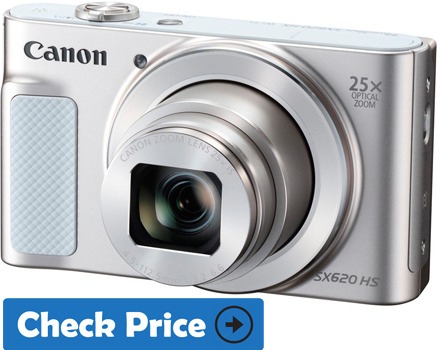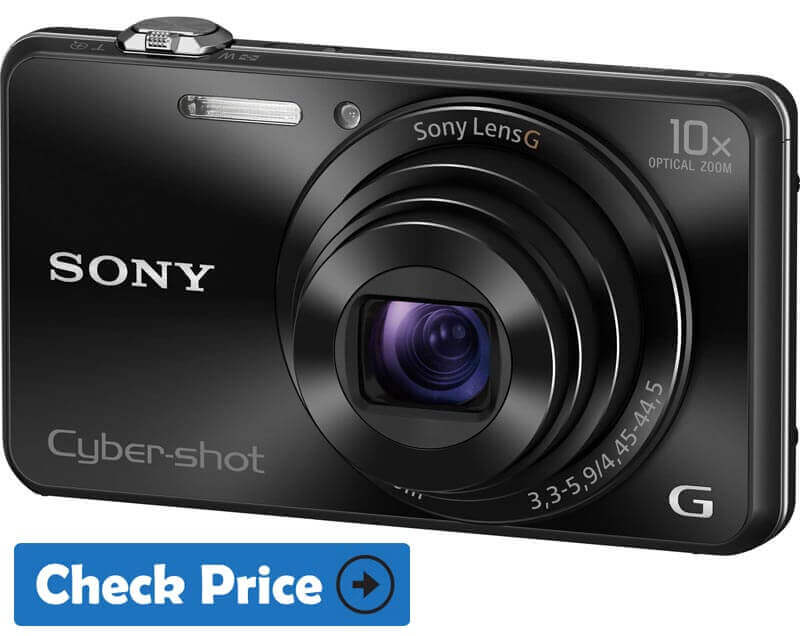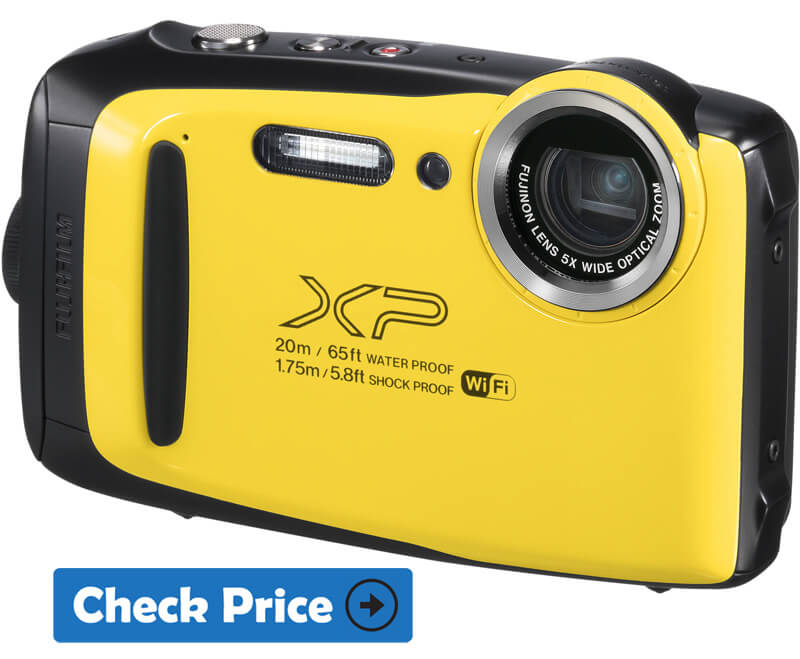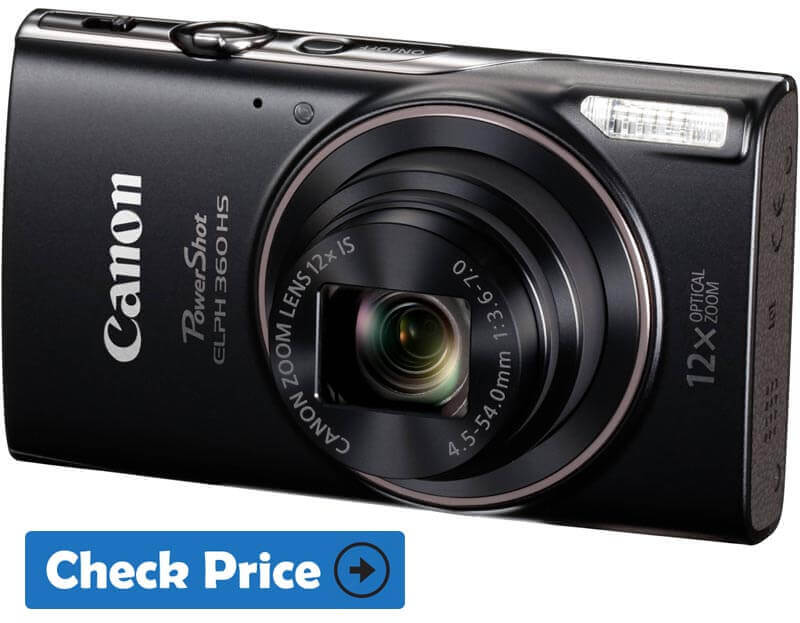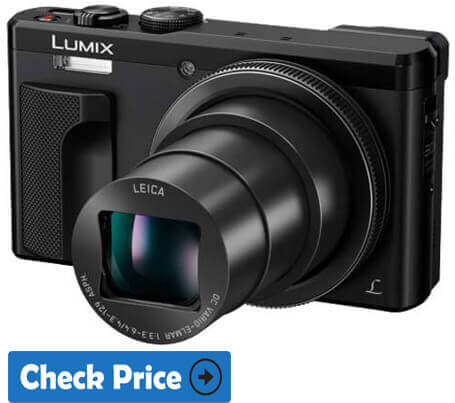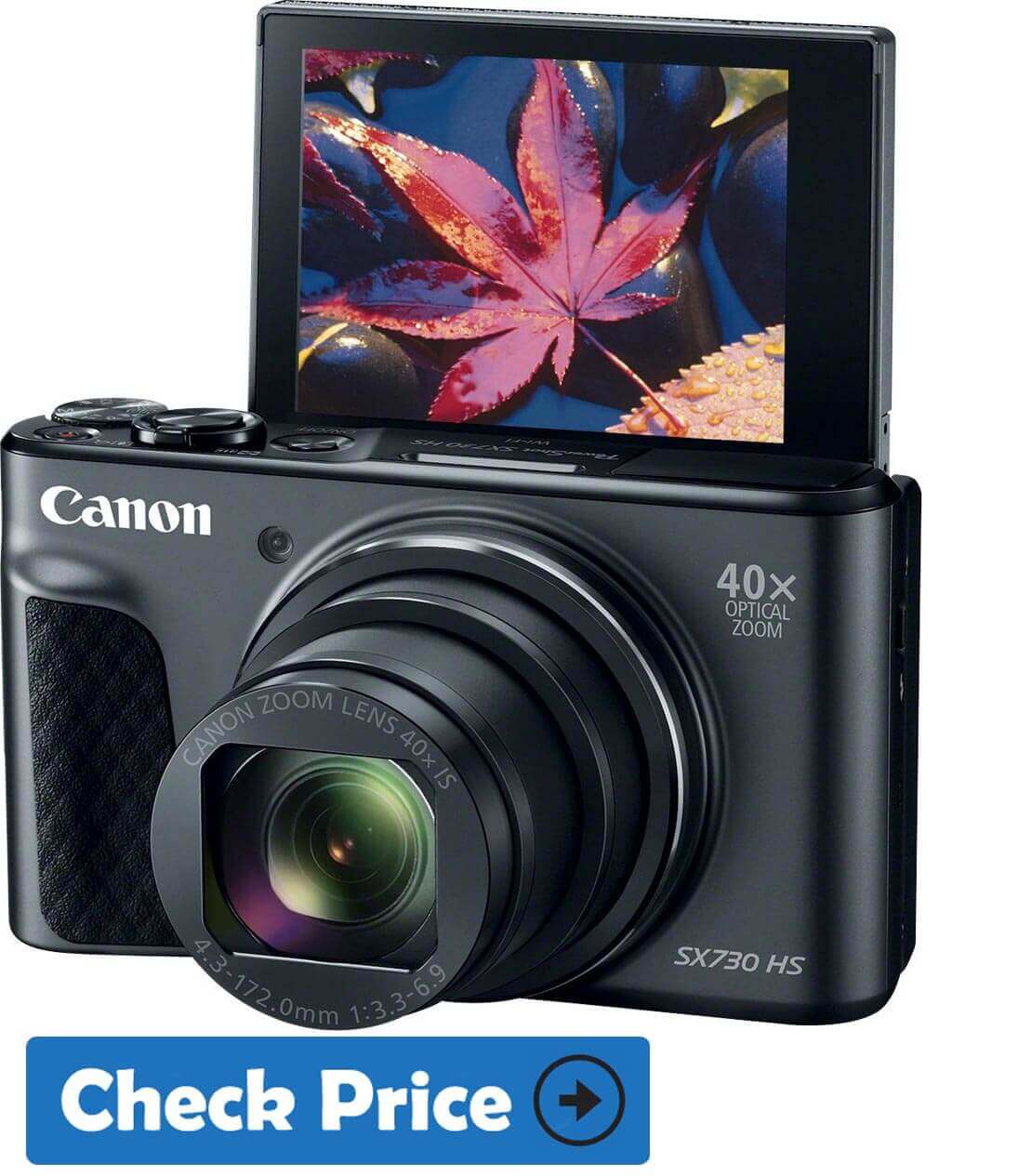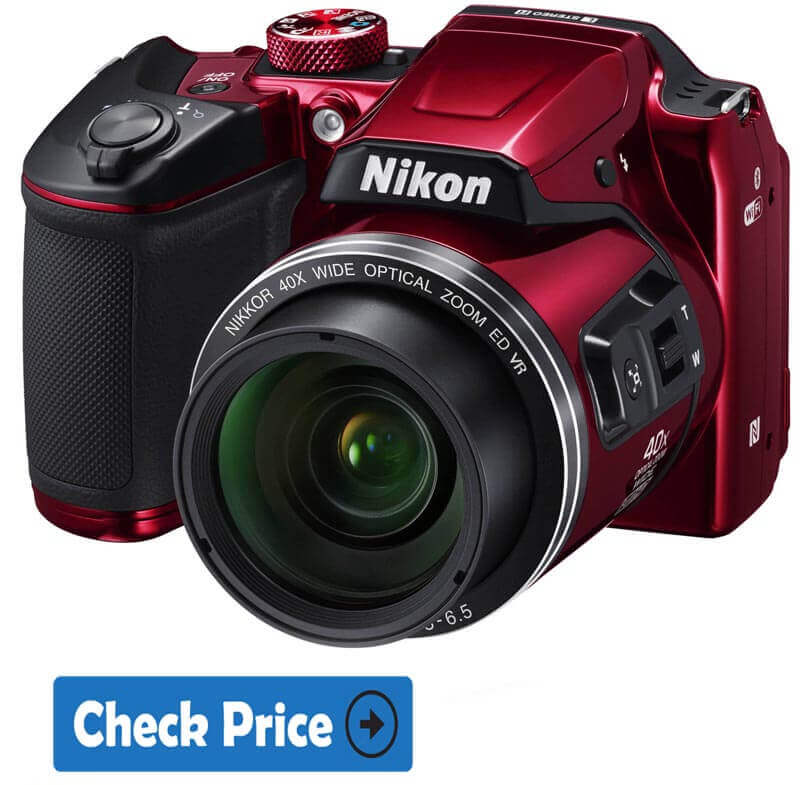If you are looking for a high quality and easy to use the camera, which one is right for you? Let’s take a look at the best point and shoot cameras under $300 for all pockets.
Now that most of us carry smartphones with large cameras, the market for point and shoot cameras is in decline. However, there are many ways that aiming and shooting is still the best option. They have zoom lenses and better battery life, for example. While for high-end models, the images will be noticeably superior.
So, if you are looking for a quality camera, but easy to use, which one is right for you? Let’s take a look at the best point and shoot camera regardless of your budget.
What is a point and shoot digital camera?
Table of Contents
As the name implies, a point-and-shoot camera is a camera designed to be easy to use – just point at the camera and press the shutter button. They can be simple compact devices that are fully automatic, or larger, more advanced options with countless modes and shooting settings.

Some may have zoom lenses, other fixed focal length lenses, but the common thing they share is that the lens is not removable, unlike a DSLR camera or without a mirror. This type of camera had been the most popular during the previous decade, but the smartphone has essentially usurped the traditional point-and-shoot domain.
Also Read: Best Vlogging Camera under $500
But many independent point and shoot, particularly the advanced models mentioned here, offer things that a smartphone cannot, and often that is due to pure physics: larger sensors, optical zoom lenses, and mechanical apertures and shutters give These cameras an image quality border.
Some, like Sony’s RX10 series, may even be movie cameras. While today’s smartphones are ideal for everyday photography and capable of capturing nice images and videos, advanced point-and-shoot smartphones go further for users who want some control over their camera
Best Point and Shoot Camera Under 300 Dollars
There are many great cameras at every price. The trick to finding the best one for you is to decide what your shooting priorities are. Do you need excellent video features? The low light benefits of a larger 1-inch sensor? Will you be shooting wildlife with a long zoom? Or maybe you just need something you can store in your pocket or purse. Deciding this will determine your search for the perfect camera.
And if you’re not sure that a point and shoot is right for you, you might consider upgrading to a mirrorless camera instead of Ditch That DSLR Camera! Why do hobbyists and travelers need to go to the mirrorless ditch of that DSLR camera?
Why fans and travelers need to go without reflexes Common knowledge says that anyone who takes photography seriously needs a DSLR. But that is no longer true. The latest mirrorless cameras match and even exceed, DSLRs in almost every way.
Best Point and Shoot Camera Under 300$ | 2025 Comparison Table
Top Quality | Great Price | 5- Star Picks
| Camera Name | Resolution | Sensor MegaPixel | Price $$ |
|---|---|---|---|
| Canon PowerShot SX620 | HD 1080p | 20.2 MP | |
| Sony Cyber-shot DSC-WX220 | HD 1080 / 60p | 18.2 MP | |
| Fujifilm FinePix XP140 | FHD 1080p | 20.3 MP | |
| Canon PowerShot ELPH 360 | FHD 1080p | 20 MP | |
| Panasonic Lumix ZS50 | FHD 1080p | 20 MP | |
| Canon PowerShot SX730 | FHD 1080p | 16 MP | |
| Nikon COOLPIX B500 | FHD 1080p | 16 MP |
Best Point and Shoot Camera Under $300 | 2025 Products Overview
1. Canon PowerShot SX620 Point & Shoot (Editor’s Choice)
- Type: Compact
- Resolution Max: 1080 30fps
- Sensor: 1″
- MegaPixels: 20.2 MP
- Focal Length: 24-105mm
- Viewfinder: No
- Screen 3″, Tilt
- Connectivity: Wifi, NFC
About:
The small camera model through which you can get very good photos. One of its strengths is its large zoom. So you can take remote photos as if you were almost next door. And all this with the advantage of not losing quality.
This camera has NFC and wifi to be able to share data easily. With this model, you can also make videos with Full Hd resolution, without forgetting that it has an intelligent system that will allow you to better square the photos and thus achieve better results. You can buy it in different colors.
Image Quality:
The PowerShot SX620 HS camera uses a highly sensitive 20.2 megapixel CMOS sensor. It provides powerful image performance and is optimized for use with compact cameras for professionals photography. Uses sophisticated light capture design to provide high ISO capture sensitivity with reduced noise. Incredibly fast, you can quickly capture image data and move it to the processor, as well as fast, continuous shooting and fast autofocus.
The Canon DIGIC 4+ image processor enhances the advanced features of the PowerShot SX620 HS camera. The acceleration of processing speed provides high-speed and responsive performance, enabling a smooth and natural shooting experience. The DIGIC 4+ image processor also improves image quality and reduces bright color noise by shortening the processing of high ISO shots by almost 60% compared to the DIGIC 4 image processor. Smooth gradation and beautiful details even in dark places.
The PowerShot SX620 HS camera is designed to make it easy and fun to shoot beautiful and creative videos. Full HD 1080p with a uniform frame rate up to 30p is bright and realistic.
Also available in MP4 format, ideal for sharing and playback on mobile devices. Dynamic IS provides image stabilization that can correct strong camera movements that can occur when shooting while running or walking backward.
Features:
25x optical zoom (25–625 mm)
With the PowerShot SX620 HS camera in hand, you will be impressed with the zoom function of this slim and compact digital camera. The incredible 25x optical zoom lens has a slim design and great zoom magnification, so you can go to the countryside. Advanced camera technology captures images and videos with excellent quality. Intelligent IS chooses a stabilization method that adapts to the shooting conditions, so the image will hardly shake in various situations.
Smart IS
Intelligent IS analyzes the movement of the camera and applies an image stabilization method suitable for the shooting situation. For still images, the system selects normal IS, panoramic IS, macro IS (hybrid), and tripod mode. When recording video, the system chooses between Dynamic IS, Powered IS, Macro IS (Hybrid), and Active Tripod IS modes. With Smart IS, you can focus on capturing images, so you can set up effective IS settings on the camera and capture stable images.
A large 3.0-inch high-resolution LCD screen makes it easy to frame and check your photos. The resolution of about 922,000 points helps to display fine details clearly, and the image can be viewed from a wide-angle, making it easy to show others what you have captured.
Hybrid Auto records up to 4 seconds of video each time you take a still image and automatically combines clips and images into a video that captures the essence of a special day: vacation, important occasion, or day Every time you take many pictures. In this mode, Hybrid Auto automatically recognizes the scene and optimizes the camera settings for very high image quality. The resulting “excellent reel” is very beautiful because the resulting 720p HD video is properly exposed, crisp and consistent.
Connectivity:
Built-in Wi-Fi technology is useful when you want to share photos and videos with friends and family on the go.
Easily publish images directly from the PowerShot SX620 HS camera via CANON iMAGE GATEWAY †, select social networks and media sites (Facebook, Twitter, YouTube, Flickr, Google Drive) or save them to an online photo album Share anytime and anywhere.
You can also connect your camera directly to iOS and Android compatible devices and upload images using the Canon Camera Connect application without a computer.
Video sharing is easy even with PowerShot cameras with Wi-Fi that record videos using the easy-to-share MP4 format. The Wi-Fi feature allows real-time publishing, so you can keep everyone up to date with photos and videos, even during the event.
With Wi-Fi technology, you can also transfer images to other PowerShot cameras with Wi-Fi, or print photos directly to a PictBridge (wireless LAN) certified printer.
Thanks to the recently added Wi-Fi Button, you can connect in both shooting and playback modes, making it quick and easy to operate. At the push of a button, you can turn on the camera and connect at the same time. This gives you the right to share and manage your files at any time.
PowerShot digital cameras with built-in NFC (Near Field Communication) technology provide high-speed, one-touch connectivity. Simply tap the camera’s NFC icon on a compatible Android device to automatically launch the Camera Connect app and share images quickly and easily.
Built-in NFC technology also makes application installation easy. If the application is not already installed, the download screen will automatically appear the first time you touch the device together.
Also Read: Best Cheap Camera For YouTube
- Image Sync Function for smartphone
- 25x Optical Zoom (25–625mm)
- Auto shake correction
- Massive connectivity options to transfer you pic
- None
2. Sony Cyber-shot DSC-WX220 Good Point & Shoot Camera
- Type: Compact
- Resolution Max: 1080 60p
- Sensor: 1″
- MegaPixels: 20.2 MP
- Focal Length: 24-105mm
- Viewfinder: No
- Screen 2.7″, Tilt
- Connectivity: Wi-Fi, NFC
About:
Take clear pictures in dark places that are n’t easy to shoot with your mobile phone. With 10x optical zoom and pocket accuracy, this Cyber-shot camera makes your phone je. You'll also enjoy the Exmor R CMOS sensor, which is lighter than most phones and records the full HD video and immortal details with incredible detail.
Image Quality:
10x optical zoom and 20x clear image digital zoom. Most digital zooms use electronic clipping to get close to the subject and produce a clear image. With Clear Image Zoom, a powerful processor compares patterns found in adjacent pixels and creates new pixels that match the selected pattern, producing a more realistic and quality image. Sharp image zoom doubles optical zoom for closer photos.
The camera features an 18.2 megapixel Exmor RCMOS image sensor that draws the maximum resolution of the camera's G lens, providing very high speed, high resolution, surprisingly low light sensitivity, and clear images. Grain decreased significantly. In addition, the CMOS Exmor R sensor and BIONZ X image processor combine to provide very fast movie modes up to 10 fps, anti-motion blur, manual twilight, and 1080p.
Record incredibly smooth video and still images using the new BIONZ X processor and Optical SteadyShot (Intelligent Active Mode). When the processor and image stabilization technology work together, you get clear image quality with low noise and no blur, even when the user is walking and magnifying the camera.
Also Read: Best Mirrorless Camera Under $1000
Features:
Record crisp movies at the highest resolution available in 60p capacity with 1080 AVCHDvideo. ¹This provides an impressive, fast movie-like video with low distortion for playback on HDTV.
Capture 18.2-megapixel full-resolution images at a rate of 10 frames per second. This ensures that decisive moments are captured, such as a soccer ball flying towards the goal. In addition, the mechanical shutter reduces distortion by continuously shooting moving subjects.
Great effect for displaying jumps, tracks and more. In MotionShot Video, captured subject movement is displayed in a series of images superimposed on a single background.
Connectivity:
Connection with a smartphone for one-touch sharing / one-touch remote control has been simplified with Wi-Fi / NFC control. In addition to Wi-Fi support for connecting to smartphones, the camera also supports NFC (Near Field Communication), which provides the convenience of “one-touch connection” when transferring images to Android smartphones and tablets. All you need to connect is a touch device. No complicated configuration is required.
In addition, if you use the smart remote control, a function that allows you to control the shutter with a smartphone, you can establish a connection with the smartphone simply by touching a compatible device.
Enjoy the beauty of 4K quality still images (4 times the resolution of full HD) via a simple HDMI connection to a compatible 4K TV 2.
- Sweep Panorama mode up to 360 °
- 4K quality image
- Pocket size camera
- Not in the list
3. Fujifilm FinePix XP140 Waterproof Point & Shoot Camera
- Type: Compact
- Resolution Max: 1080 60p
- Sensor: 1″
- MegaPixels: 20.2 MP
- Focal Length: 24-105mm
- Viewfinder: No
- Screen 3″, Tilt
- Connectivity: Wi-Fi, NFC
About:
FINEPIX XP130 is the latest model in the robust camera category of the XP series. The camera is water resistant to 65 feet, shock resistant up to 5.8 feet, anti-freezing to 14ºF, and dustproof, making it ideal for any outdoor adventure.
Also Read: Best Budget Underwater Camera
Image Quality:
The camera is equipped with a 16.4 megapixel backlit CMOS sensor, which provides advanced image quality even in the water or in dark places.
Despite the larger 3-inch high-resolution 920K dot LCD monitor, this camera maintains a compact size with a weight of about 207g * 4. The LCD monitor has an anti-reflective coating that makes it easy to use even in bright and sunny places. Brightness is automatically adjusted to maintain optimal visibility.
Features:
The indomitable FinePix XP130 is equipped with a FUJINON 5x internal optical zoom lens (28-140 mm **), so you can zoom in action even in water. Technology continues to apply intelligent digital zoom. FinePix XP130 combines its 5x optical zoom with intelligent digital zoom to achieve a 2x zoom range (10x) and provide optimal image processing to counter the degradation that was used when using digital zoom.
If you use the camera underwater, Fujifilm photos will be reproduced as seen by the human eye.
XP130 The 3.0-inch FinePix LCD screen enables electronic levels. This is especially useful for capturing horizontal subjects, such as beautiful landscapes or solid buildings. The eye-detection function makes it easier to capture.
Thanks to the CMOS sensor, FinePix XP130 can record 1920 x 1080 pixel full HD video. With the dedicated video recording button, you can easily switch to video recording mode with one touch.
Sometimes things are too fast to see correctly with your own eyes. FinePix XP130 can freeze actions up to 320 fps! So you can see every minute and see things happen in slow motion.
You can pair your smartphone and camera to synchronize location information and time information.
Choose from 11 special filters to create unique photo effects. You can check the filter effect on the LCD monitor and get the desired result.
Also Read: Best Action Cameras Under $100
Connectivity:
Enable low-energy Bluetooth continuous connection using a smartphone or tablet to share images from the camera to the device. Instax SHARE printers also offer wireless transfer, so you can access instant prints and enjoy them from anywhere.
Use the FUJIFILM Camera Remote application on your smartphone or tablet to open the shutter remotely and set the setting to video recording mode. This feature is useful for capturing wild animals, group photos, and self-portraits.
- Waterproof to 65ft
- Shockproof to 5.8ft
- Freezeproof to 14°F
- An excellent alternative not mounted on GoPro
- Wide ISO range from 100 to 12800
- Automatically assign location and timestamp to photos
- 11 special advance filtes
4. Canon PowerShot ELPH 360
Specification:
- Type: Compact
- Resolution Max: 1080 60p
- Sensor: 1″
- MegaPixels: 20.2 MP
- Focal Length: 24-105mm
- Viewfinder: No
- Screen 3″, Tilt
- Connectivity: Wi-Fi
About:
The Canon Powershot ELPH 360 HS digital camera is small, versatile and fits in your pocket. With the included Wi-Fi and NFC, you can easily share your best moments. In addition, creative options are endless with automatic hybrid mode, creative shooting, and story highlights. From the maker: day or night for bold photos.
For photo beginners who want to save the magical moments of everyday life, the elegant PowerShot ELPH 360 HS camera is thin enough to be placed where you need it when you need it.
The 12x optical zoom is useful for taking a close-up view of a child's face on the stage, or for taking a picture of the entire play and the general public.
Image Quality:
The 20.2 megapixel CMOS sensor and DIGIC 4+ image processor provide detailed images, while Intelligent IS and optical image stabilization keeps images sharp with minimal blur.
You can record an unforgettable movie in 1080p full HD resolution and view the full image on a crisp 3.0-inch LCD screen to make sure you have the image you want. Auto hybrid mode captures a short video a few seconds before capturing an image.
The recently added story highlight mode combines images and video, then adds the appropriate effects to create a short movie of the best part of the day.
Features:
The PowerShot ELPH 360 HS camera has a 12x optical zoom for spectacular shots at your fingertips. I like the flexibility of shooting in the amazing range of 25-300 mm (equivalent to 35 mm) with a thin and compact camera. In addition, the wide-angle lens captures vast images with each shot, adding depth, perspective, and greatness. Landscapes, cityscapes, family photos, etc. can benefit by adding width. Whether you're taking a large group photo or zooming in with a telephoto lens, the image is bright and clear.
Using a specific PowerShot camera, you can easily capture clear and stable images in dark places without using a tripod. This is because these cameras are equipped with Canon's innovative Intelligent IS.
The system automatically analyzes camera movements and applies the ideal shock correction method to the shooting situation, allowing you to focus on the frame and capture the shot.
For still images, the system selects normal IS, panoramic IS, macro IS (hybrid), and tripod mode. When recording video, the system chooses between Dynamic IS, Powered IS, Macro IS (Hybrid), and Active Tripod IS modes. The icon clearly indicates the image stabilization mode whether you are shooting a still image or a video.
Connectivity:
Built-in Wi-Fi technology provides comfort when you want to share photos and videos with friends and family while traveling. Easily publish images from PowerShot ELPH 360 HS cameras via CANON iMAGE GATEWAY to social networks and media sites (Facebook, Twitter, YouTube, Flickr, Google Drive) or save and share them in online photo albums at any time, anywhere.
You can also connect your camera directly to iOS and Android compatible devices and upload images using the free Canon Camera Connect application without a computer. Control upload destinations to share with everyone, select groups, and add comments.
The Wi-Fi feature enables real-time publishing, so you can keep everyone up to date with photos and videos, even during events. Using Wi-Fi technology, you can also transfer images to other PowerShot cameras with Wi-Fi, or print photos directly to a PictBridge (wireless LAN) certified printer.
Thanks to the recently added Wi-Fi Button, you can connect in both shooting and playback modes, making it quick and easy to operate. At the push of a button, you can turn on the camera and connect at the same time. This gives you the right to share and manage your files whenever you need them.
The PowerShot ELPH 360 HS camera supports NFC (Near Field Communication) technology for high-speed one-touch connection. Simply tap the camera's NFC icon on a compatible Android device and the Canon Camera Connect app will automatically begin sharing images quickly and easily. Built-in NFC technology also makes application installation easy. If the application is not already installed, the download screen will automatically appear the first time you touch the device together.
- Multiple IS modes for movies and photos.
- Easy digital transfer to social media accounts
- an effective Use DIGIC 4+ image processor
- Remote shooting via phone or tablet
5. Panasonic Lumix ZS50
Specification:
- Type: Compact
- Resolution Max: 1080 60p
- Sensor: 1″
- MegaPixels: 20.2 MP
- Focal Length: 24-105mm
- Viewfinder: No
- Screen 3″, Tilt
- Connectivity: Wi-Fi, NFC
About:
Expand your field of view with LUMIX ZS50. With a wide range of image functions, you can clearly capture any subject in a dark place.
Image Quality:
Records at 100 fps in HD resolution and 200 fps in VGA. With high-speed video, you can record and record fast-moving actions and later enjoy them in crystal slow motion.
Features:
It shoots at the same speed with light speed autofocus and 10fps high-speed burst shot, always taking a perfectly focused image.
It has a 30x durable optical zoom, you can approach each subject more clearly.
Even in dark environments, you can capture image noise in greater detail using the new high-sensitivity MOS sensor with large pixel size and Venus Engine image processor. And enjoy amazing photos and videos.
It has a Precise live viewfinder that helps you take a picture wherever you are. Ideal for framing images when it is difficult to use an LED display due to lighting conditions. The eye sensor automatically detects the display settings and switches to LVF. The high resolution of 1,166k points and the color reproduction of about 100% provide stable framing and excellent visibility under any lighting conditions.
A control ring attached to the lens facilitates manual control of exposure, zoom, and focus, allowing you to focus on shutter operations. Intuitive design, precise focus, and smooth and quiet operation give you complete control over all the photos and videos you create.
It has 5-axis optical image stabilization automatically detects and corrects camera shake according to the movements of the five types of cameras. When shooting, Level Shot detects and corrects horizontal recording lines even when the camera is tilted. The result is a clear and perfect photo and video.
To capture details, shoot in RAW format. The image data retains the original color and light information captured by the camera sensor with minimal processing. You can also edit amazing quality images directly for amazing results.
Position the camera to record the natural drama of the rising sun, moon setting, or blooming flowers. Just set the start time, shooting interval, and the number of images you need. The camera automatically handles the rest in full HD quality.
Connectivity:
- Bright and stable in low light environment
- Use your favorite Leica lens
- Live viewer promises a resolution of 1,166k points
- Manual focus, exposure, zoom control.
- No touchscreen
6. Canon PowerShot SX730 Flip Screen Camera
- Type: Compact
- Resolution Max: 1080 60p
- Sensor: 1″
- MegaPixels: 20.2 MP
- Focal Length: 24-105mm
- Viewfinder: No
- Screen 3″, Tilt
- Connectivity: Wi-Fi, NFC
About:
Use the PowerShot SX730 HS digital camera's powerful 40x optical zoom to shoot subjects near, far and in the middle. When using longer focal lengths, take magnificent pictures with Zoom Framing Assist.
The new 180 ° tilt screen looks forward to putting you in the heart of perfect selfies. Smooth skin effects, now available in all modes, help improve natural characteristics. Share photos and videos instantly using built-in generic Bluetooth1 and built-in Wi-Fi2 and NFC3 technology.
Image Quality:
It has a 20.3 megapixel 6 high-sensitivity CMOS sensor that provides powerful image performance and is optimized for use with selected compact cameras. Uses sophisticated light capture design to provide high ISO capture sensitivity with reduced noise. Incredibly fast, you can quickly capture image data and move it to the processor, as well as fast, continuous shooting and fast autofocus.
The DIGIC 6 image processor helps improve the quality of high-resolution still images and video with minimal noise when shooting in dark environments, and Dynamic IS helps create a video that is virtually undistorted. The processor also enables continuous capture of high-speed, high-quality still images up to 5.9 frames per second. Video recording is impressive with 60p Full HD and MP4 recording. The DIGIC 6 image processor also offers MF Peaking. This gives you the freedom to provide an accurate focus tool.
PowerShot SX730 HS's new high-resolution tilt screen brings a unique perspective to the world. With about display. 922,000 points, tilt the screen 180 degrees and turn forward to confirm that you are in the center of a perfect selfie. Or you can push the screen down 90 degrees to see the world from a lower angle.
Also Read: Best Cheap Digital Camera Under $50
Features:
Its Advanced camera stabilization technology allows you to capture images and videos with superior quality with Intelligent IS, which selects the stabilization method that suits your shooting conditions. With Zoom Framing Assist, you can automatically zoom in and out while tracking the movement of the subject so you can focus and get the best composition.
The overall size of the PowerShot SX730 HS means that it is ready to be stored in a pocket and capture the action that occurs. In addition to the textured surface and anti-slip shape, the camera's large front and rear grips help you feel comfortable in your hand.
Self-portrait mode helps you take ideal selfies. Easy access from the menu. Alternatively, tilt the screen and look forward to activating automatically. When shooting, you can make various adjustments such as soft skin tone, background blur, and brightness. A customizable timer gives you enough time to smile, correct your expressions, and get your friends to take pictures. Smooth skin mode helps you refine your portrait in both self-portrait mode and other shooting modes and looks amazingly beautiful.
The PowerShot SX730 HS is designed to make it easy and fun to shoot beautiful and creative videos. Full HD 1080p is bright and realistic, with selectable frame rates of 60p, 30p, and 24p to adapt to different situations. Also available in MP4 format, ideal for sharing and playback on mobile devices. This makes it possible to compensate for camera movement that occurs when shooting while driving or traveling backward.
Connectivity:
Thanks to the built-in Wi-Fi2 technology and the Canon Camera Connect app, you can use the PowerShot SX730 HS to transfer photos and videos to and from compatible devices and upload directly to various web services.
Built-in NFC technology allows the camera to connect directly to compatible devices. Bluetooth1 pairing allows you to easily connect the PowerShot SX730 HS from a compatible smartphone and control it remotely.
Remote shooting using compatible smart devices is easy with the built-in Wi-Fi2 and the free Canon Camera Connect2 app or built-in Bluetooth1 connection.
- Dynamic IS provides 5-axis image stabilization
- versatile and compact
- Flip Screen for Vloggers
- No viewfinder
7. Nikon COOLPIX B500 Fastest Shutter Speed
- Type: Compact
- Resolution Max: FHD 1080 60p
- Sensor: 1″
- MegaPixels: 16 MP
- Focal Length: 24-105mm
- Viewfinder: LCD
- Screen 3″, Tilt
- Connectivity: Wi-Fi, NFC bluetooth
About:
The Nikon COOLPIX B500 digital camera fits in when you zoom in with a super telephoto NIKKOR glass lens or record 1080p full HD video using a flip-down LCD screen.
Also, all work by taking beautiful photos and videos with a 16-megapixel low light sensor, vibration reduction (VR) lens replacement, simple menu and controls, fun creative effects, and excellent automatic operation Is unnecessary.
The COOLPIX B500 connects to compatible smartphones easily and seamlessly via Bluetooth Low Energy (BLE) technology to share photos instantly and remotely control the camera. Simply bright
Image Quality:
Features:
Its 40x optical zoom provides super telephoto power, and the dynamic zoom and enhanced digital zoom effectively double the incredible 80x zoom range. Vibration reduction (VR) using lens shift keeps important shots stable at such long distances, and a backlit 16 megapixel CMOS sensor captures details.
The COOLPIX B500's large, tiltable LCD screen makes it easy to create shots and monitor video recordings. You can also use it to find new and exciting shooting angles. It is also a pleasure to review and share your work. All shots and videos look stunning on a high-resolution screen.
It's so easy to use that anyone can take great photos and videos. Just turn on the camera, aim, shoot and watch the results. To maximize point and shooting convenience, select Easy Auto Mode. Automatically optimize camera settings for each shot, no matter how difficult it is. You can shoot while enjoying the moment.
It is also a powerful video camera. Capturing full HD 1080p quality moments in stereo sound and praising how the video's 4-axis hybrid vibration reduction (VR) uses a stable tripod to offset handshake. Transform regular videos into exciting, fast-moving sequences with a new super lapse movie feature ideal for first-person perspectives, sports moments, and video tours.
Connectivity:
You can Install the new Nikon Snapbridge application on a compatible smartphone or tablet and unlock new exciting features with COOLPIX B500.
Built-in Wi-Fi, NFC, and Bluetooth Low Energy (BLE) maintain a constant connection between the application and the camera, so each shot taken is automatically transferred to your smartphone or tablet for sharing, editing, Or upload to your favorite site. You can also control the camera remotely using the Snapbridge application!
- 74 fps Continuous Shooting
- Full HD 1080p resolution
- Fast Shutter
Best Point and Shoot Camera Under $300 | Buyer’s Guide 2025
Buying a good camera is not an easy task. We do not have to make the mistake of buying the first one we find, but it is very important to compare and when we have the decision, make the purchase.
Before starting to investigate, we must take into account the budget we have to make the purchase. Depending on what we are willing to spend, we can access a camera of more or less quality. And remember, it is also very important to consider the use that we will give it. It is silly to buy one of the best cameras on the market if we only want to take pictures occasionally.
Also, Read our Camera Buying Guide, you will get a lot of knowledge and be able to make the best buying decision.
Camera and Sensor Resolution
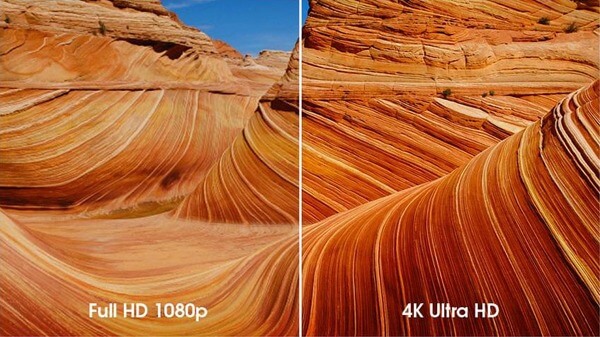 The most common element when classifying products in almost any comparison of point & shoot cameras is its sensor as well as its resolution. A fundamental question if we consider that this sensor is the only one responsible for taking the images, unlike the support mirror that the SLR cameras have for this purpose.
The most common element when classifying products in almost any comparison of point & shoot cameras is its sensor as well as its resolution. A fundamental question if we consider that this sensor is the only one responsible for taking the images, unlike the support mirror that the SLR cameras have for this purpose.
Thus, starting with the resolution, most cameras in the market are around 24 megapixels, in a resolution that has become the most common standard in the market. A resolution that is usually accompanied by quality sensors, capable of taking images in a short time, which helps us avoid problems of focus or see how the object to be photographed disappears.
In this last aspect, the double approach system that includes some products is very interesting. This system maintains the conventional approach but adds a second approach, which allows the object to be photographed to be controlled and combines both images. Something that joins the stabilizer when it comes to obtaining better photos and a more considerable definition in them.
Battery
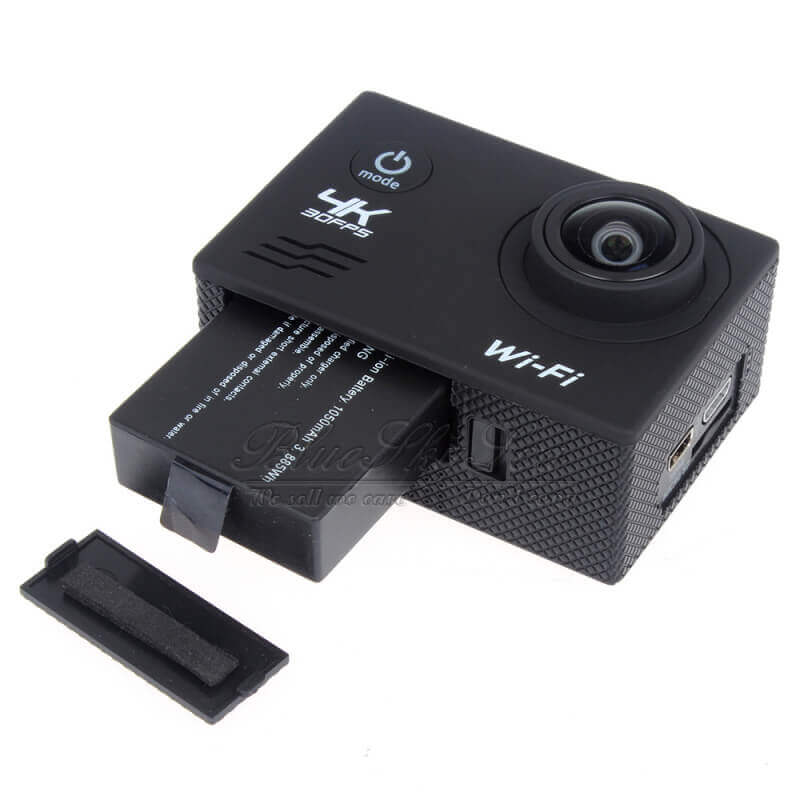
The most important element of the camera is the battery, with which we will see the autonomy that the camera has when it comes to enduring our day. Many models have a battery whose capacity is measured in shots, being able to take approximately 400 or 500 photos. Others have autonomy in time of use. In any case, it is appropriate to assess that autonomy and see if it adapts to our needs.
Weight
Something similar happens with the size of the product. By definition, EVIL cameras are quite compact and lightweight, although there are always classes within the current offer. As proof, we have the heaviest cameras, which reach 400 grams, compared to those with a weight that barely exceeds 225 grams. An aspect that is also perceived in the dimensions of the camera, which should be verified in order not to buy a product that does not adapt to the use we are going to give it.
Connectivity
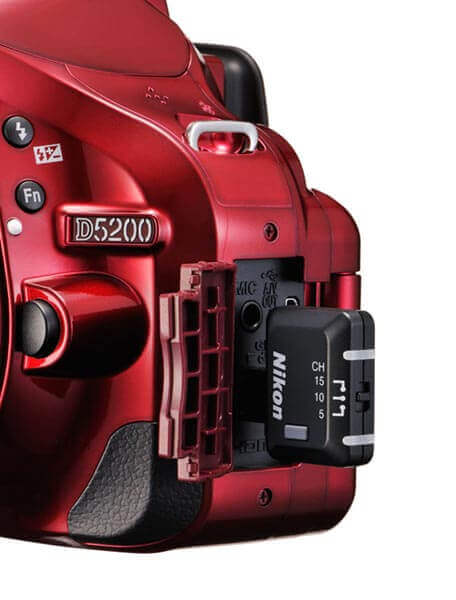
Some models can even be controlled from the mobile, for which the camera includes connection functions via WiFi or Bluetooth, as well as NFC, with which to simplify the connection. It all depends on your budget and what you want to have at your disposal.
FAQs
Why buy a point and shoot camera?
With a camera inside each smartphone, why buy a point and shoot camera? The aim and shoot cheap has stayed on the road in the last decade as the cameras of the phones have been improving, but as the low-cost compact cameras disappear, manufacturers have moved to higher-end models.
Dedicated cameras usually offer two great advantages compared to a smartphone: a zoom lens and / or a larger sensor. Although the phones that now offer three or more lenses, point and shoot can have a 30x zoom and remain compact, or a 125x zoom with a larger body.
The advanced point-and-shoot system also has larger sensors than a phone's camera, which means better image quality, more control over depth of field (allowing background blur while maintaining the sharpness of the subject) and sharper images in low light settings.
how to clean point and shoot camera lens?
Cleaning the lens of a point-and-shoot camera is an important part of maintaining its image quality. Here are some steps you can follow to clean your camera lens:
- Gather your materials: You will need a clean microfiber cloth and a lens cleaning solution designed for camera lenses. Avoid using any household cleaners or paper products, which can scratch the lens.
- Turn off the camera: Before cleaning the lens, turn off the camera and remove the battery to prevent accidental damage.
- Blow off any loose dust: Use a blower brush or compressed air to gently blow away any loose dust or debris from the lens.
- Apply lens cleaning solution: Apply a small amount of lens cleaning solution to a corner of your microfiber cloth. Avoid applying the solution directly to the lens.
- Gently wipe the lens: Using the damp corner of your microfiber cloth, gently wipe the lens in a circular motion. Be careful not to press too hard, as this can scratch the lens.
- Dry the lens: Once you have wiped the lens with the damp cloth, use a dry portion of the microfiber cloth to gently dry the lens. Be sure to remove any remaining cleaning solution.
- Inspect the lens: After cleaning the lens, inspect it for any remaining smudges or debris. If necessary, repeat the cleaning process.
It's important to clean your camera lens regularly to ensure optimal image quality. However, be careful not to over-clean the lens, as this can cause damage. If you're unsure about cleaning your camera lens, consider taking it to a professional for cleaning.
Is It Worth Getting A Point Shoot Camera?
Yes, it can be worth getting a point-and-shoot camera, depending on your photography needs and preferences. Here are some reasons why a point-and-shoot camera can be a good choice:
- Portability: Point-and-shoot cameras are typically small and lightweight, making them easy to carry around for everyday use and travel. This makes them a convenient option for capturing moments on the go.
- Ease of use: Point-and-shoot cameras are designed for easy operation, with automatic settings and intuitive controls. They are a good choice for those who want to take photos without worrying about manual settings or technical knowledge.
- Affordability: Point-and-shoot cameras are generally more affordable than other types of cameras, such as DSLRs or mirrorless cameras. This makes them accessible to a wider range of photographers, including beginners and those on a budget.
- Image quality: While point-and-shoot cameras may not offer the same level of image quality as higher-end cameras, many models have advanced features such as image stabilization, high zoom range, and fast autofocus, which can produce high-quality images in a variety of settings.
Overall, if you're looking for a camera that is portable, easy to use, and offers good image quality for everyday photography, a point-and-shoot camera can be a good choice. However, if you're looking for advanced features or the highest level of image quality, you may want to consider a higher-end camera.
What Is the Best Budget Camera?
There are many great budget cameras available on the market today, and the best one for you will depend on your specific needs and preferences. Here are a few options to consider:
Canon EOS Rebel T7: This DSLR camera offers great image quality and a user-friendly interface, making it a great choice for beginners. It typically comes with a kit lens and is priced at around $500.
Nikon D3500: Another popular entry-level DSLR, the Nikon D3500 offers excellent image quality, fast autofocus, and good battery life. It is also priced at around $500 with a kit lens.
Sony Alpha a6000: This mirrorless camera offers fast autofocus, good image quality, and compact size, making it a great choice for travel photography. It is priced at around $550 with a kit lens.
Fujifilm X-T200: This mirrorless camera offers excellent image quality and advanced features such as 4K video recording, a fully articulating touchscreen, and film simulation modes. It is priced at around $700 with a kit lens.
Panasonic Lumix ZS80: This point-and-shoot camera offers a versatile zoom range, good image quality, and advanced features such as 4K video recording and post-focus. It is priced at around $400.
These are just a few examples of great budget cameras available on the market. When choosing a camera, be sure to consider your specific needs, such as the type of photography you will be doing and the features that are most important to you. It's also a good idea to read reviews and compare specs to help you make an informed decision.
How Do I Choose A Point Shoot Camera?
Choosing a point-and-shoot camera can seem overwhelming with so many options available. Here are some factors to consider when choosing a point-and-shoot camera:
- Image quality: Look for a camera with a high resolution and image sensor size. Generally, the larger the image sensor, the better the image quality.
- Zoom range: Consider the zoom range of the camera. Some point-and-shoot cameras have a wide zoom range, while others have a more limited zoom range.
- Aperture: The aperture is the opening in the lens that lets light in. Look for a camera with a wide aperture (lower f-number) for better low-light performance and more control over the depth of field.
- Size and portability: One of the main advantages of point-and-shoot cameras is their compact size, making them easy to carry around. Consider the size and weight of the camera when choosing.
- Features: Look for cameras with features that are important to you, such as image stabilization, manual controls, WiFi connectivity, and video recording.
- Brand and price: Consider the reputation of the brand and the price of the camera. While more expensive cameras may have more advanced features, there are many affordable options available that still offer good performance.
- Reviews and recommendations: Read reviews and seek recommendations from other photographers to get an idea of the camera's performance and user experience.
Overall, when choosing a point-and-shoot camera, it's important to consider your specific needs and preferences. Look for a camera with the features and performance that will best suit your style of photography.
What Is The Most Cheapest Camera In The World?
It's difficult to determine the absolute cheapest camera in the world, as the price of cameras can vary widely depending on various factors such as availability, location, and currency exchange rates. However, there are some low-cost options available that may be considered the most affordable cameras.
One such option is the Vivitar VXX14 Digital Camera, which is priced at around $20-$30 USD. It is a very basic point-and-shoot camera with a 20-megapixel sensor, a fixed lens, and simple controls. It does not offer many advanced features, but it is very affordable and can be a good option for someone who just needs a basic camera for casual photography.
Another option is the Polaroid Snap Instant Digital Camera, which is priced at around $50-$70 USD. This camera has a 10-megapixel sensor and produces 2x3-inch prints on ZINK paper. It also has a built-in flash, and self-timer, and can store images on a microSD card.
It's important to keep in mind that while these cameras may be the most affordable options, they may not offer the best image quality or features. Additionally, they may not be as durable or long-lasting as more expensive cameras. It's always a good idea to do research and read reviews before making a purchase to ensure that you are getting a camera that will meet your needs and expectations.
Why Buy A Dslr Instead Of A Point-And-Shoot?
There are several reasons why someone might choose to buy a DSLR instead of a point-and-shoot camera:
- Image quality: DSLR cameras typically have larger image sensors than point-and-shoot cameras, which can result in better image quality with less noise and better low-light performance.
- Flexibility: DSLR cameras offer more control over settings such as aperture, shutter speed, and ISO, allowing photographers to achieve a wider range of creative effects and to adapt to different shooting situations.
- Lens selection: DSLR cameras typically offer a wide selection of interchangeable lenses, allowing photographers to choose the best lens for each situation, such as a wide-angle lens for landscapes or a telephoto lens for wildlife photography.
- Speed and responsiveness: DSLR cameras typically have faster autofocus and shooting speeds, making them a better choice for action photography or capturing fast-moving subjects.
- Durability: DSLR cameras are often built with more robust materials and weather-sealed to withstand more challenging shooting environments.
While point-and-shoot cameras are more compact and convenient to carry, they often have limitations in terms of image quality, control, and flexibility. For photographers who prioritize image quality and creative control, a DSLR camera may be the better choice. However, it's important to consider your specific needs and preferences when choosing a camera, as there are many great options available in both categories.
Is Dslr Better Than Point-And-Shoot?
Whether a DSLR is better than a point-and-shoot camera depends on your needs and preferences as a photographer.
DSLR cameras typically have larger image sensors, which can result in better image quality with less noise and better low-light performance. They also offer more control over settings such as aperture, shutter speed, and ISO, allowing photographers to achieve a wider range of creative effects and adapt to different shooting situations. DSLRs also offer the flexibility of interchangeable lenses, allowing photographers to choose the best lens for each situation.
On the other hand, point-and-shoot cameras are typically smaller and more compact, making them easier to carry around. They often have more automated features, making them simpler to use, and they're usually less expensive than DSLRs. Point-and-shoot cameras can also be better for candid shots, as their smaller size and less conspicuous appearance can make subjects feel less self-conscious.
Ultimately, the decision of whether a DSLR is better than a point-and-shoot camera depends on your individual needs as a photographer. If you value image quality and control over your shots, a DSLR may be the better choice. If portability and ease of use are more important to you, a point-and-shoot camera may be the better option.
Is Canon Better Than Nikon?
Canon and Nikon are both excellent camera brands with a long history of producing high-quality cameras and lenses. There is no straightforward answer to the question of whether one brand is better than the other, as both brands offer a range of cameras and lenses that cater to different types of photographers and shooting situations.
Some photographers prefer Canon cameras for their color science, which can produce warmer and more vibrant colors, while others prefer Nikon cameras for their dynamic range and low-light performance. Both brands offer a wide range of cameras, from entry-level DSLRs to professional-grade full-frame mirrorless cameras, and both have their strengths and weaknesses in terms of autofocus, image stabilization, video capabilities, and lens selection.
Ultimately, the choice between Canon and Nikon comes down to personal preference and the specific needs of the photographer. It's important to do your research, read reviews, and try out different cameras and lenses before making a decision.
Is Nikon Cheaper Than Canon?
The price of Nikon and Canon cameras and lenses can vary depending on the model and features, so it's difficult to make a general comparison in terms of price.
In some cases, Nikon cameras and lenses may be more expensive than their Canon counterparts, while in other cases, the opposite may be true. For example, Nikon's professional-grade D6 camera is currently priced higher than Canon's flagship EOS-1D X Mark III camera, but Nikon's entry-level D3500 camera is priced lower than Canon's entry-level EOS Rebel T8i camera.
It's also worth noting that both Canon and Nikon offer a range of cameras and lenses at different price points, so there are options available for photographers with different budgets. When choosing a camera or lens, it's important to consider factors such as image quality, autofocus performance, lens selection, and overall value for money, rather than simply comparing prices between brands.
Which Camera Is Used By Youtubers?
Many YouTubers use a variety of cameras depending on their needs and preferences. Some popular cameras among YouTubers include:
- Canon EOS R5: A full-frame mirrorless camera that offers excellent autofocus, 8K video capabilities, and a high-resolution sensor.
- Sony A7S III: Another full-frame mirrorless camera that offers impressive low-light performance, 4K video capabilities, and a range of professional features.
- Panasonic Lumix GH5: A Micro Four Thirds mirrorless camera that is popular among YouTubers for its high-quality 4K video capabilities and built-in image stabilization.
- Canon EOS 90D: An APS-C DSLR that offers good image quality, fast autofocus, and a flip-out screen that is useful for vlogging.
- Sony RX100 VII: A compact point-and-shoot camera that offers excellent image quality, fast autofocus, and a range of video features.
These are just a few examples, and there are many other cameras that YouTubers use depending on their needs and preferences. When choosing a camera for YouTube, it's important to consider factors such as image quality, autofocus performance, video capabilities, and overall ease of use.
Is Canon Or Nikon Better For Beginners?
Both Canon and Nikon offer excellent cameras for beginners, so the choice between the two ultimately comes down to personal preference and the specific needs of the photographer. Here are a few factors to consider when choosing between Canon and Nikon for beginners:
- Ease of use: Both Canon and Nikon offer entry-level DSLR cameras that are designed to be easy to use, with intuitive menus and controls that are accessible to beginners. Some models even offer guided modes that walk you through the process of taking certain types of shots.
- Lens selection: Both Canon and Nikon offer a wide range of lenses that are compatible with their cameras, so there are options available for photographers of all skill levels and shooting styles. Some photographers may prefer Canon's selection of lenses for their color rendering, while others may prefer Nikon's lenses for their sharpness and low-light performance.
- Price: Entry-level Canon and Nikon DSLR cameras are priced similarly, so cost shouldn't be a major factor in the decision between the two. However, it's worth comparing the features and capabilities of different models to find the best value for your money.
Ultimately, the choice between Canon and Nikon comes down to personal preference and the specific needs of the photographer. Both brands offer excellent cameras and lenses for beginners, so it's worth trying out different models and reading reviews before making a decision.
Do Professional Photographers Use Point-And-Shoot?
While some professional photographers may occasionally use point-and-shoot cameras for certain types of photography, they are generally not the primary tool of choice for professional work.
Professional photographers typically use high-end DSLR or mirrorless cameras with larger sensors, interchangeable lenses, and advanced features such as fast autofocus, high burst rates, and excellent low-light performance. These cameras allow photographers to capture high-quality images in a wide range of shooting conditions, and offer greater control over factors such as depth of field, shutter speed, and ISO.
That being said, point-and-shoot cameras can still be useful for certain types of photography, such as street photography, travel photography, or casual snapshots. They are often smaller and more portable than DSLR or mirrorless cameras, making them easier to carry around and use in a variety of situations. Additionally, many point-and-shoot cameras now offer advanced features such as high-resolution sensors, fast autofocus, and 4K video capabilities, which make them more versatile than ever before.
Is A Point Shoot Camera Better Than A Phone?
While both point-and-shoot cameras and smartphones have their strengths and weaknesses, point-and-shoot cameras generally offer better image quality, greater zoom capabilities, and more advanced features than smartphones.
Point-and-shoot cameras typically have larger sensors than smartphones, which allows them to capture more detail and produce higher-quality images, especially in low-light conditions. They also offer optical zoom lenses, which allow you to zoom in on your subject without losing image quality, whereas smartphones rely on digital zoom, which can lead to pixelated or blurry images.
Additionally, point-and-shoot cameras often offer more advanced features such as manual controls, faster autofocus, and better image stabilization, which give photographers greater control over their shots and can help them achieve better results.
That being said, smartphones have their own advantages, such as portability, convenience, and ease of use. For casual snapshots and everyday photography, a smartphone may be perfectly adequate, especially if you don't want to carry a separate camera around with you.
In summary, while both point-and-shoot cameras and smartphones have their strengths and weaknesses, point-and-shoot cameras generally offer better image quality and more advanced features than smartphones, especially for those who want to take their photography to the next level.
How Many Megapixels Is 4k?
4K refers to a video resolution of 3840 x 2160 pixels, which means that a 4K video frame contains approximately 8.3 million pixels. However, when it comes to still photos, the number of megapixels required for a 4K resolution image can vary depending on the aspect ratio and level of detail in the photo.
For example, a 16:9 aspect ratio photo with 3840 pixels on the long edge would require approximately 7.8 megapixels to achieve a 4K resolution. However, a photo with a different aspect ratio or higher levels of detail may require more megapixels to achieve the same resolution.
It's worth noting that while megapixels are important for determining image resolution, they are not the only factor that affects image quality. Other factors such as sensor size, lens quality, and image processing capabilities can also have a significant impact on the final image quality.
Which Is Better Mirrorless Or Dslr?
The choice between a mirrorless camera and a DSLR ultimately depends on your specific needs and preferences.
Mirrorless cameras tend to be smaller and more compact than DSLRs, making them easier to carry around and use in a wider range of situations. They also tend to be quieter and faster than DSLRs, thanks to their electronic shutters and advanced autofocus systems. Additionally, many mirrorless cameras offer advanced video features such as 4K video recording and in-body image stabilization.
DSLRs, on the other hand, have been the standard for professional photographers for decades and offer a proven, reliable design. They typically offer larger sensors, which can result in better image quality and better low-light performance. DSLRs also have a wider range of lenses available, including many high-quality professional-grade lenses.
That being said, many mirrorless cameras now offer similar image quality and performance to DSLRs, and their smaller size and advanced features make them an attractive option for many photographers. Additionally, the gap between DSLRs and mirrorless cameras is narrowing as technology continues to improve.
In summary, both mirrorless cameras and DSLRs have their strengths and weaknesses, and the choice between the two ultimately comes down to your specific needs and preferences. If you value portability and advanced features, a mirrorless camera may be the better choice, whereas if you need the highest possible image quality and a wider range of lens options, a DSLR may be the way to go.
What Is The Coolest Camera In The World?
The definition of the "coolest" camera in the world can vary depending on individual preferences and needs. However, here are some cameras that are often considered to be cool or unique:
- Leica M10 Monochrome: This camera is a high-end digital rangefinder camera that is designed exclusively for black-and-white photography. Its retro design and high-quality build have made it a popular choice among photography enthusiasts.
- Fujifilm X100V: This compact camera has a retro-inspired design and features a hybrid viewfinder that can switch between optical and electronic modes. It also has a high-quality fixed lens and advanced features such as 4K video recording.
- Hasselblad X1D II 50C: This medium-format mirrorless camera is known for its sleek and minimalist design, as well as its high-resolution 50-megapixel sensor. It's a favorite among professional photographers for its image quality and ease of use.
- Lomography Lomo'Instant Wide: This instant film camera has a quirky design and produces unique, retro-looking photos. It's a fun and creative option for those who want to experiment with instant photography.
- Sony A7S III: This mirrorless camera is designed specifically for video production, with advanced features such as 4K/120fps recording, in-body image stabilization, and a low-light sensitivity of up to ISO 409,600. It's a powerful and versatile tool for videographers and content creators.
These are just a few examples of cameras that are often considered to be cool or unique. Ultimately, the coolest camera in the world is the one that best suits your needs and preferences as a photographer or videographer.
Conclusion
Finally, you must think that there is no perfect camera, that is, you have to look for the ones that give you the most things that interest you and not the perfect camera. If you are able to find what you really need, you will not only feel comfortable with the camera, but you will have the assurance of having made an appropriate purchase.
